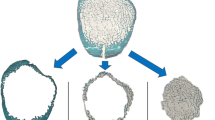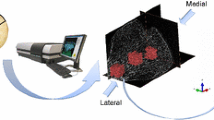Abstract
Summary
We investigated age- and gender-related variation of both cortical and trabecular microstructure in human femoral neck. We found that age-related change of cortical porosity is more noticeable than that of trabecular parameter. Our data may help to gain more insight into the potential mechanism of osteoporotic femoral neck fractures.
Introduction
Variations in the microstructure of cortical and trabecular bone contribute to decreased bone strength. Age- and gender-related changes in cortical and trabecular microstructure of femoral neck is unclear. The aim of this study was to identify three-dimensional (3D) microstructural changes of both cortical and trabecular bone simultaneously in human femoral neck with age and gender, using micro-computed tomography (micro-CT). We hypothesized that there would be differences in age-related changes of cortical and trabecular bone for both women and men.
Methods
We used 56 femoral necks of 28 women and men (57–98 years of age) from a Japanese population. The subjects were chosen to give an even age and gender distribution. Both women and men were divided into three age groups: middle (57–68 years), old (72–82 years), and elderly (87–98 years) groups. We examined cortical bone specimen from the inferior sector of femoral neck and trabecular bone specimen from the middle of femoral neck using micro-CT and 3D bone analysis software.
Results
Cortical thickness (Ct.Th) decreased by 10–15%, cortical porosity (Ca.V/TV) almost doubled, and canal diameter (Ca.Dm) increased by 65–77% between the middle-aged and elderly groups for both women and men. The trabecular bone volume fraction (BV/TV) decreased by around 20%; trabecular thickness (Tb.Th), trabecular number (Tb.N), and connectivity density (Conn.D) decreased; and trabecular separation (Tb.Sp) and structure model index (SMI) increased with age for both women and men. As compared with women, men had higher Ct.Th and BV/TV and lower Ca.V/TV and Ca.Dm among three age groups. There was a significant inverse correlation between Ca.V.TV and BV/TV for both women and men.
Conclusion
Our findings indicate that Ct.Th and BV/TV decreased, and Ca.V/TV and Ca.Dm increased in femoral neck with age for both women and men. The most obvious age-related change is the increase of Ca.V/TV. The decrease of BV/TV with age is more noticeable than that of Ct.Th. This is the first study that has provided both cortical and trabecular microstructural data simultaneously in a Japanese sample. These data may help us to gain more insight into the potential mechanism of osteoporotic femoral neck fractures.







Similar content being viewed by others
References
Duque G, Troen BR (2008) Understanding the mechanisms of senile osteoporosis: new facts for a major geriatric syndrome. J Am Geriatr Soc 56:935–941
Dubey A, Koval KJ, Zuckerman JD (1999) Hip fracture epidemiology: a review. Am J Orthop 28:497–506
Cummings SR, Melton LJ (2002) Epidemiology and outcomes of osteoporotic fractures. Lancet 359:1761–1767
Johnell O, Kanis JA (2004) An estimate of the worldwide prevalence, mortality and disability associated with hip fracture. Osteoporos Int 15:897–902
Nieves JW, Formica C, Ruffing J et al (2005) Males have larger skeletal size and bone mass than females, despite comparable body size. J Bone Miner Res 20:529–535
Looker AC, Beck TJ, Orwoll ES (2001) Does body size account for gender differences in femur bone density and geometry? J Bone Miner Res 16:1291–1299
Slemenda C, Longcope C, Peacock M et al (1996) Sex steroids, bone mass, and bone loss. A prospective study of pre-, peri-, and postmenopausal women. J Clin Invest 97:14–21
Ahlborg HG, Johnell O, Nilsson BE et al (2001) Bone loss in relation to menopause: a prospective study during 16 years. Bone 28:327–331
Ahlborg HG, Johnell O, Turner CH et al (2003) Bone loss and bone size after menopause. N Engl J Med 349:327–334
Bell KL, Loveridge N, Power J et al (1999) Structure of the femoral neck in hip fracture: cortical bone loss in the inferoanterior to superoposterior axis. J Bone Miner Res 14:111–119
Lotz JC, Cheal EJ, Hayes WC (1995) Stress distribution within the proximal femur during fait and falls: Implications for osteoporotic fracture. Osteoporos Int 5:252–261
Bell KL, Loveridge N, Power J et al (1999) Regional differences in cortical porosity in the fractured femoral neck. Bone 24:57–64
MacCalden RW, McGeough JA, Barker MB et al (1993) Age-related changes in the tensile properties of cortical bone. J Bone Joint Surg Am 75:1193–1205
Yeni YN, Norman TL (2000) Fracture toughness of human femoral neck: effect of microstructure, composition, and age. Bone 26:499–504
Schaffler MB, Burr DB (1988) Stiffness of compact bone: effects of porosity and density. J Biomech 21:13–16
Cui WQ, Won YY, Baek MH et al (2008) Age-and region-dependent changes in three-dimensional microstructural properties of proximal femoral trabeculae. Osteoporos Int 19:1579–1587
Lundeen GA, Vajda EG, Bloebaum RD (2000) Age-related cancellous bone loss in the proximal femur of caucasian females. Osteoporos Int 11:505–511
Eckstein F, Matsuura M, Kuhn V et al (2007) Sex differences of human trabecular bone microstructure in aging are site-dependent. J Bone Miner Res 22:817–824
Lochmüller EM, Matsuura M, Bauer J et al (2008) Site-specific deterioration of trabecular bone architecture in men and women with advancing age. J Bone Miner Res 23:1964–1973
De Laet CE, van Hout BA, Burger H et al (1997) Bone density and risk of hip fracture in men and women: cross sectional analysis. Brit Med J 315:221–225
Mayhew PM, Thomas CD, Clement JG et al (2005) Relation between age, femoral neck cortical stability, and hip fracture risk. Lancet 366:129–135
Bousson V, Peyrin F, Bergot C et al (2004) Cortical bone in the human femoral neck: three-dimensional appearance and porosity using synchrotron radiation. J Bone Miner Res 19:794–801
Boyce TM, Bloebaum RD (1993) Cortical aging differences and fracture implications for the femoral neck. Bone 14:769–778
Nägele E, Kuhn V, Vogt H et al (2004) Technical considerations for microstructural analysis of human trabecular bone from specimens excised from various skeletal sites. Calcif Tissue Int 75:15–22
Chen H, Shoumura S, Emura S et al (2008) Regional variations of vertebral trabecular bone microstructure with age and gender. Osteoporos Int 19:1473–1483
Chen H, Zhou X, Washimi Y et al (2008) Three-dimensional microstructure of the bone in a hamster model of senile osteoporosis. Bone 43:494–500
Cooper DM, Thomas CD, Clement JG et al (2007) Age-dependent change in the 3D structure of cortical porosity at the human femoral midshaft. Bone 40:957–965
Hildebrand T, Rüegsegger P (1997) A new method for the model-independent assessment of thickness in three-dimensional images. J Microsc (Oxford) 185:67–75
Martín-Badosa E, Elmoutaouakkil A, Nuzzo S et al (2003) A method for the automatic characterization of bone architecture in 3D mice microtomographic images. Comput Med Imaging Graph 27:447–458
Ulrich D, van Rietbergen B, Laib A et al (1999) The ability of three-dimensional structural indices to reflect mechanical aspects of trabecular bone. Bone 25:55–60
Odgaard A, Gundersen HJ (1993) Quantification of connectivity in cancellous bone, with special emphasis on 3-D reconstructions. Bone 14:173–182
Lorensen WE, Cline HE (1987) Marching cubes: a high resolution 3D surface construction algorithm. Comput Graph 21:163–169
Hildebrand T, Rüegsegger P (1997) Quantification of bone microarchitecture with the structure model index. Comput Methods Biomech Biomed Engin 1:15–23
Odgaard A (1997) Three-dimensional methods for quantification of cancellous bone architecture. Bone 20:315–328
Harrigan TP, Mann RW (1984) Characterization of microstructural anisotropy in orthotropic materials using a second rank tensor. J Mater Sci 19:761–767
Hildebrand T, Laib A, Müller R et al (1999) Direct three-dimensional morphometric analysis of human cancellous bone: microstructural data from spine, femur, iliac crest, and calcaneus. J Bone Miner Res 14:1167–1174
Squillante RG, Williams JL (1993) Videodensitometry of osteons in females with femoral neck fractures. Calcif Tissue Int 52:273–277
Barth RW, Williams JL, Kaplan FS (1992) Osteon morphometry in females with femoral neck fractures. Clin Orthop Rel Res 283:178–186
Bousson V, Meunier A, Bergot C et al (2001) Distribution of intracortical porosity in human midfemoral cortex by age and gender. J Bone Miner Res 16:1308–1317
Bell KL, Loveridge N, Reeve J et al (2001) Super-osteons (remodeling clusters) in the cortex of the femoral shaft: influence of age and gender. Anat Rec 264:378–386
Jordan GR, Loveridge N, Bell KL et al (2000) Spatial clustering of remodeling osteons in the femoral neck cortex: a cause of weakness in hip fracture? Bone 27:185–195
Khosla S, Riggs BL, Atkinson EJ et al (2006) Effects of sex and age on bone microstructure at the ultradistal radius: a population-based noninvasive in vivo assessment. J Bone Miner Res 21:124–131
Stauber M, Müller R (2006) Age-related changes in trabecular bone microstructures: global and local morphometry. Osteoporos Int 7:616–626
McCalden RW, McGeough JA, Court-Brown CM (1997) Age-related changes in the compressive strength of cancellous bone. The relative importance of changes in density and trabecular architecture. J Bone Joint Surg Am 79:421–427
Parfitt AM, Mathaws CH, Villaneuva AR et al (1983) Relationship between surface, volume, and thickness of iliac trabecular bone in aging and in osteoporosis. Implications for the microanatomic and cellular mechanisms of bone loss. J Clin Invest 72:1396–1409
Riggs BL, Parfitt AM (2005) Drugs used to treat osteoporosis: the critical need for a uniform nomenclature based on their action on bone remodeling. J Bone Miner Res 20:177–184
Nazarian A, Muller J, Zurakowski D et al (2007) Densitometric, morphometric and mechanical distributions in the human proximal femur. J Biomech 40:2573–2579
Ding M, Odgaard A, Linde F et al (2002) Age-related variations in the microstructure of human tibial cancellous bone. J Orthop Res 20:615–621
Bousson V, Le Bras A, Roqueplan F et al (2006) Volumetric quantitative computed tomography of the proximal femur: relationships linking geometric and densitometric variables to bone strength. Role for compact bone. Osteoporos Int 17:855–864
Turner CH (2005) The biomechanics of hip fracture. Lancet 366:98–99
Bouxsein ML, Fajardo RJ (2005) Cortical stability of the femoral neck and hip fracture risk. Lancet 366:1523–1524
Manske SL, Liu-Ambrose T, Cooper DM et al (2009) Cortical and trabecular bone in the femoral neck both contribute to proximal femur failure load prediction. Osteoporos Int 20:445–453
Hordon LD, Peacock M (1990) The architecture of cancellous and cortical bone in femoral neck fracture. Bone Miner 11:335–345
Lang TF, Keyak JH, Heitz MW et al (1997) Volumetric quantitative computed tomography of the proximal femur: precision and relation to bone strength. Bone 21:101–108
Sigurdsson G, Aspelund T, Chang M et al (2006) Increasing sex difference in bone strength in old age: The Age, Gene/Environment Susceptibility-Reykjavik Study (AGES-REYKJAVIK). Bone 39:644–651
Riggs BL, Melton LJ 3rd, Robb RA et al (2004) Population-based study of age and sex differences in bone volumetric density, size, geometry, and structure at different skeletal sites. J Bone Miner Res 19:1945–1954
Acknowledgment
The authors thank Dr. Ken-ichi Tezuka, Department of Tissue and Organ Development, Gifu University Graduate School of Medicine, for providing micro-CT system used in this study.
Conflicts of interest
None.
Author information
Authors and Affiliations
Corresponding author
Rights and permissions
About this article
Cite this article
Chen, H., Zhou, X., Shoumura, S. et al. Age- and gender-dependent changes in three-dimensional microstructure of cortical and trabecular bone at the human femoral neck. Osteoporos Int 21, 627–636 (2010). https://doi.org/10.1007/s00198-009-0993-z
Received:
Accepted:
Published:
Issue Date:
DOI: https://doi.org/10.1007/s00198-009-0993-z




